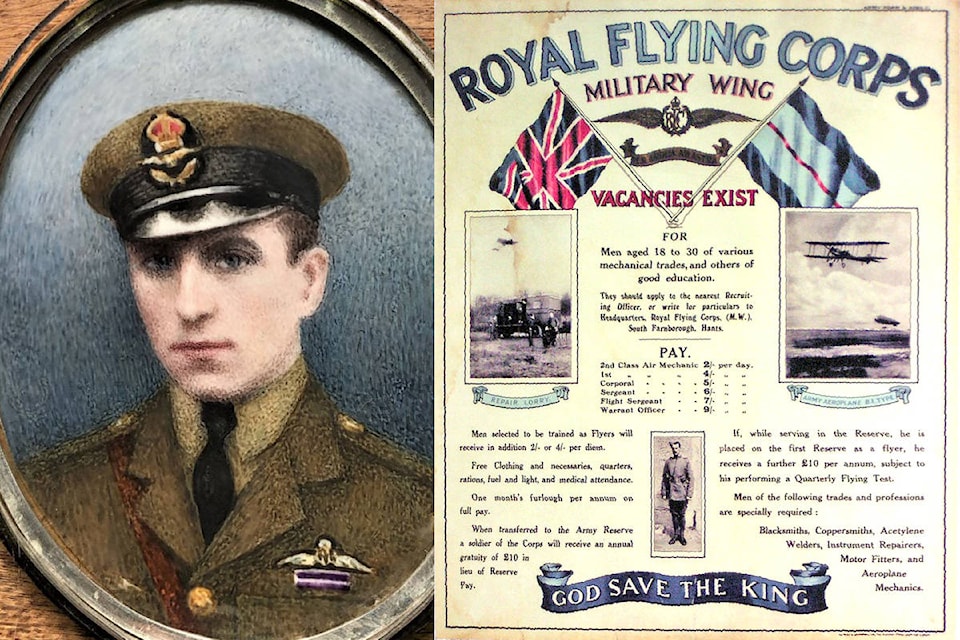Nanaimo’s best-known First World War ace, Raymond Collishaw, has a cadet squadron and airport terminal named for him in his hometown.
But Nanaimo produced another WWI ace, too, whose heroics aren’t forgotten, but aren’t as well-recognized.
Lieut. Osborne Orr, who had five aerial victories before he was killed in combat, was featured by Nanaimo’s Vancouver Island Military Museum in a newsletter this year, with the headline “Nanaimo hero rediscovered.”
Americans have sometimes claimed the Royal Air Force lieutenant as Orr lived, worked and met his wife in the U.S. Midwest in his early adulthood, but those claims are “easily proved not true,” wrote Angus Scully in his article.
Orr was born in Nanaimo in 1895 to a shoe store owner and the family moved to Vancouver about six years later to open a shoe store there. When he was 18, Osborne Orr went to visit an uncle in Minnesota, where he seems to have met his future wife and worked as a shoe salesman before returning to Vancouver and marrying in 1917, Scully wrote. Two weeks after getting married, Orr joined the Royal Flying Corps in Toronto and later sailed to England to join the Royal Air Force.
The RAF was only just being formed at the time, as ‘air supremacy’ was a relatively new concept. Historian Norman Franks, in American Aces of World War I, wrote that aircraft and design production from the start to the end of the war was “near miraculous.”
“In 1914 most military men considered the aeroplane little more than a curiosity of only marginal practical value,” Franks wrote. “By 1918 it had been developed into a thoroughly practical machine in its many forms. Four years of war had increased technological development to an unprecedented rate.”
READ ALSO: Nanaimo flying ace Raymond Collishaw was a sky hero
As Scully wrote in a separate piece, “flying was a new adventure and flying in combat had glamour” but it was dangerous, with average life expectancy at 69 flying hours.
“Despite this mortality rate, for many young men, the call to be a pilot was irresistible,” Scully wrote.
Orr became a second lieutenant in March 1918, notes the Aerodrome website. Three weeks later, the Royal Air Force was formed and the former No. 4 Squadron of the Royal Naval Air Service was re-designated No. 204 Squadron of the RAF, according to RAF Squadrons: A Comprehensive Record of the Movement and Equipment of all RAF Squadrons and their Antecedents since 1912 by C.G. Jefford.
At the time, Orr and the 204th were based on the front lines at Bray-Dunes near Dunkirk, France, and moved around some of the aerodromes around Dunkirk before settling at Téteghem, France, Jefford wrote.
Orr flew the famous Sopwith Camel and “he was a good pilot and good shot,” Scully wrote. Orr scored his first two victories the same day Aug. 12, 1918, shooting down Fokker D.VIIs over Blankenberghe and Zeebrugge-Ostend in Belgium. Over the next few days, Orr added two more victories in Roeselare and Menen.
Orr’s fifth and final victory came Oct. 14, 1918, over Westende-Nieuwpoort. A week and half later, Oct. 23, he and others in his squadron were shot down over Dendermonde in an encounter with a dozen German fighters.
“His flight had just completed a bombing mission when it was engaged by enemy fighters near Termonde,” the Aerodrome notes. “In the battle that followed, Orr and four other Sopwith Camel pilots were killed in action.”
Orr’s body was never found. A service and casualty form in the Royal Air Force Museum shows that six days after he was shot down, O.J. Orr was marked down as ‘missing.’ He was 23 years old.
Nineteen days after Orr’s death, the Great War ended. He was post-humously awarded the Distinguished Flying Cross and is memorialized as part of the Arras Flying Services Memorial in Pas de Calais, France, according to the Canadian Virtual War Memorial.
“Thus,” concluded Scully, “Two men from Nanaimo became fighter aces in the Great War.”
The Vancouver Island Military Museum will be open 11:15 a.m.-4 p.m. on Nov. 11. Admission is free on Remembrance Day.
For more news from Vancouver Island and beyond delivered daily into your inbox, please click here.
READ ALSO: Nanaimo’s legion halls decide to close on Remembrance Day as a COVID-19 precaution
editor@nanaimobulletin.com
Like us on Facebook and follow us on Twitter
